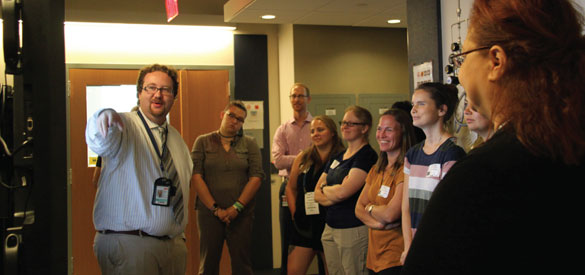Convention-goers get a peek at DC Public Health Lab
Dead mosquitoes large and small, colorful Petri dishes, and fluorescent-green rabies antibody tests were among the sights during two Aug. 1 tours at the District of Columbia Department of Forensic Sciences for some of the attendees at AVMA Convention 2019 in Washington, D.C.
The groups went behind the scenes at the department's Public Health Laboratory. According to a fact sheet, in the department's 2018 fiscal year, "PHL conducted over 4,000 test procedures including influenza subtyping, rabies testing, arbovirus screening, and testing for foodborne outbreaks."
Kicking off the tour was Tony Tran, PHL director and a doctor of public health, who described some of the laboratory's activities. The PHL does mosquito surveillance for West Nile virus and hoped to start tick surveillance this summer. For rabies testing, the laboratory aims to move to a procedure involving a real-time polymerase chain reaction assay for rapid results.

Other activities range from an air monitoring program for bioterrorism weapons to testing for sexually transmitted diseases, Zika virus, meningitis, and antimicrobial-resistant infections. The laboratory does whole genome sequencing for outbreaks of foodborne disease and for influenza, the latter key because so many people come in and out of Washington, D.C.
The PHL has an area designated biosafety level 3, the second-highest level, to test for agents of bioterrorism. People entering the area must pass an iris scan, a badge scan, and another iris scan.
The PHL also serves as the local drug laboratory. Forensic chemical testing still mostly turns up cannabinoids, legal for recreational and medical use in D.C. Opioid surveillance finds both fentanyl and heroin, with fentanyl being far more potent than heroin.
Another part of the Department of Forensic Sciences is the Forensic Science Laboratory Division. On the way out, tour participants saw displays illustrating the work of the Latent Fingerprint Unit and the Firearms Examination Unit, including a mounted array of firearms.
Dr. Shannon Greeley, medical director for the Scottsdale Animal Clinic in Burbank, Illinois, a suburb of Chicago, found the tour to be a very valuable experience. She said, "It was a demonstration of one health in action."
Dr. Greeley presented a poster at AVMA Convention 2019 titled "Milestones in the History of One Health." Back home, she is active in the Chicago VMA, which is working on a program for veterinarians to report animal diseases. She said the tour showed the importance of surveillance in human and animal populations.
Related JAVMA content:
Delving into Forensics (July 1, 2012)